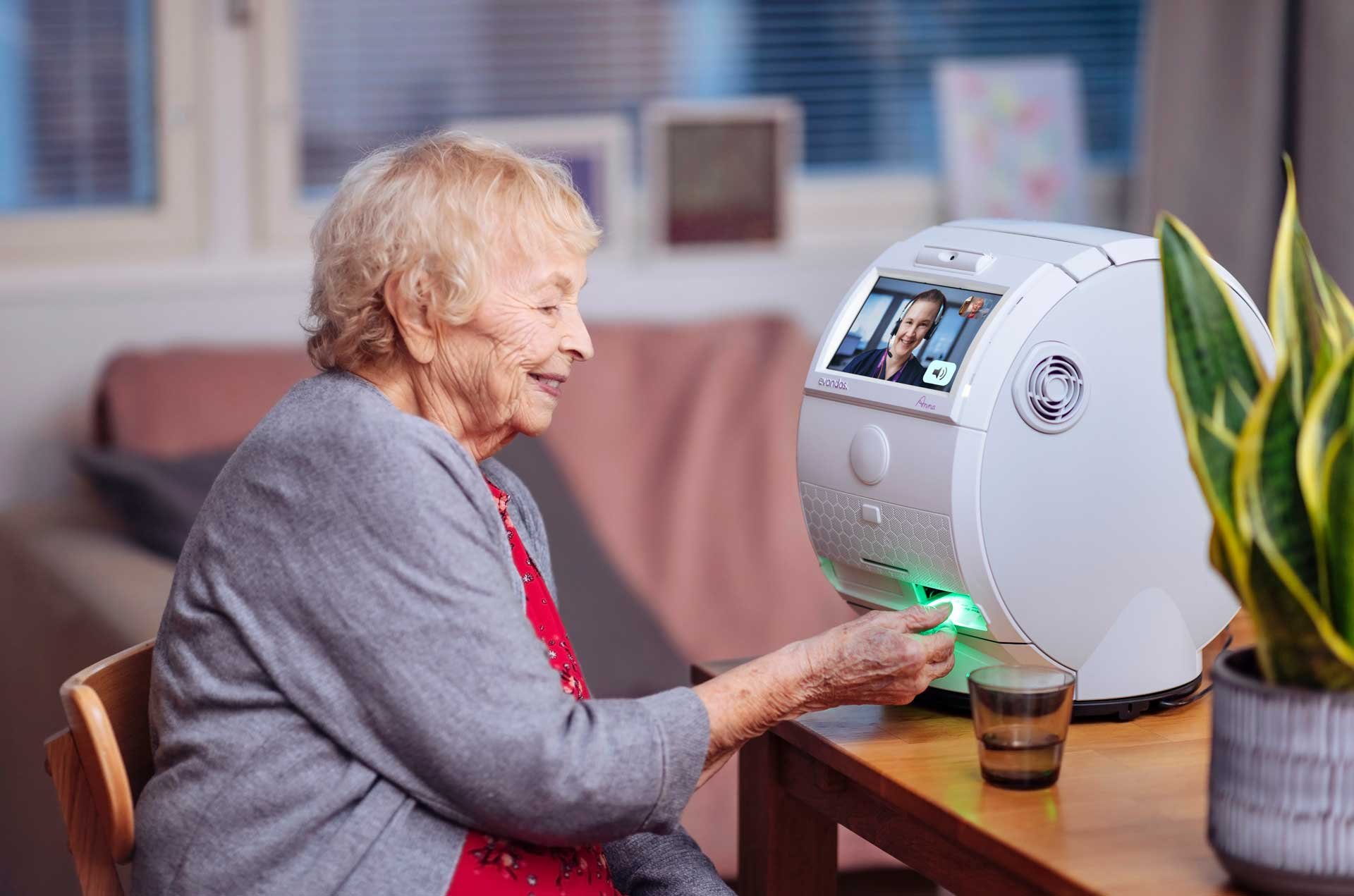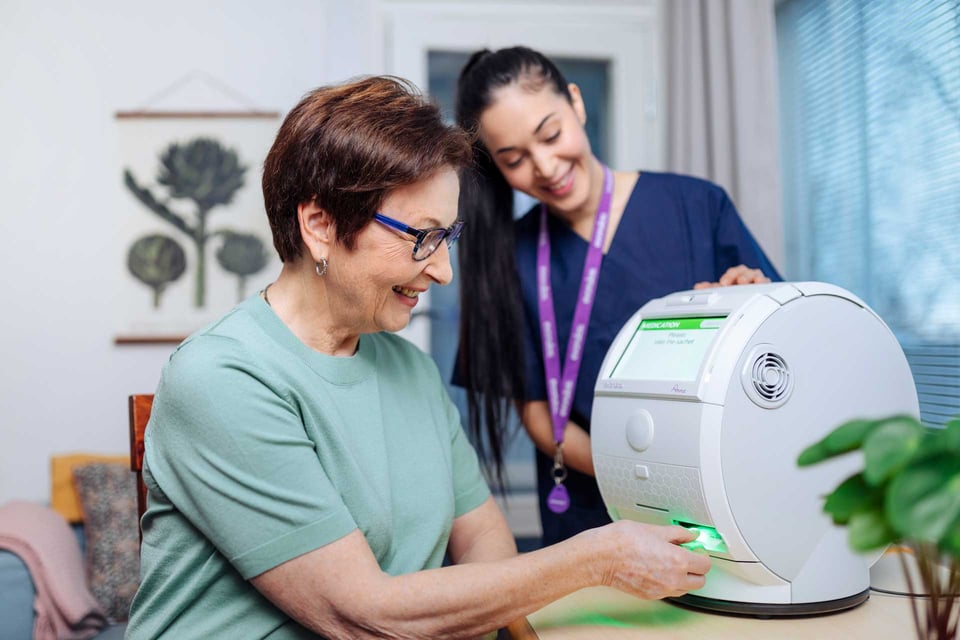
How it works
- Our Service
- Municipality
- How it works
A medicine dispensing robot has a wide range of impacts
The Evondos service improves the quality and effectiveness of home care:
- Adherence to pharmacotherapy. The robot directs the client to take medicines at the right time, which is important when treating Parkinson’s disease and other disorders. The service informs care staff if a dose has not been taken on time.
- Improved drug safety. Care staff and relatives (where requested) can monitor medication remotely. The robot always dispenses the intended dose and withholds further medication.
- Reduced need for routine pharmacotherapy calls. Home calls may focus on administering therapeutic measures.
- Care staff working hours are easier to plan with fewer medication-related calls and pressure is taken off-peak times in the morning and afternoon.
- Independent living is experienced by the home care client, which again in many instances has proven to reduce the need for help with other vital tasks.

High-quality care, high medical adherence
The Evondos service is intended for individuals in cases where there are uncertainties in implementing independent pharmacotherapy. A medicine-dispensing robot ensures that the user gets the right medicines at the right time and that future doses are kept out of the user’s reach in a locked medicine container.
Deploying a medicine-dispensing robot improves the quality of home care. The Evondos medicine delivery service significantly improves the safety of pharmacotherapy by almost completely ruling out the medication errors that account for more than half of all treatment errors made in Finland.
Evondos service clients have taken more than 30 million doses delivered by a medicine-dispensing robot, at the right time and in the right dosage. The service has enhanced the medical adherence of clients to record high levels of 99 percent. The Evondos service enables monitoring of pharmacotherapy, maintaining an electronic treatment record of each dose taken so that individual pharmacotherapy can be followed up.
A survey of homecare staff and clients is conducted when deploying the Evondos service. Both staff and clients have praised the service. The staff find that medicine-dispensing robots make their work easier, while clients are pleased with the additional freedom and support for independent living that they provide.
Proven results
Reducing the number of pharmacotherapy-related calls was one aim of an Evondos pilot project conducted by the Central Ostrobothnia Joint Municipal Authority for Social and Health (Soite).
This project successfully reduced the monthly total number of home calls from 518 to 182, eliminating 336 calls through the use of ten medicine-dispensing robots, or 34 home calls for each homecare client using a medicine-dispensing robot.
/Infographs/Monthly%20visits%20reduced/monthly_visits_reduced_EN_01.png?width=2480&height=2067&name=monthly_visits_reduced_EN_01.png)
/Other%20page%20images/Morning%20rush%20detailed/morning_rush_detailedEN@3x.png?width=1801&height=1066&name=morning_rush_detailedEN@3x.png)
Advantages and benefits
Several local authorities have reviewed the financial impacts of using the Evondos service. The service has helped to reduce the need for medication calls, assigning responsibility for taking medicines to the client with the robot providing support and assistance.
The City of Oulu has become the first local authority in Finland to incorporate the Evondos service into its homecare portfolio for all clients. The city estimates that the service will improve the quality of pharmacotherapy for 40 percent of homecare clients, but that deployment is only financially justifiable for about one-fifth. Oulu began extensive deployment of the Evondos service in November 2018.
Care functions are largely scheduled in the morning, making this the busiest time of day for care staff. Technology can help to relieve pressures at this peak time. Alleviating the morning rush can also reduce costs. Staffing of work shifts is often determined according to morning or evening peak period requirements, meaning that any alleviation of these peak times would also create an opportunity to even out staffing levels.
Pharmacotherapy is often time-critical, meaning that medicines must be taken at a certain time in order for treatment to proceed as planned by a medical practitioner. This constrains care staff work plans and nursing schedules. A medicine-dispensing robot can help to alleviate the pressures caused by this time-critical process, enabling more flexible planning of work schedules, for example with homecare calls shifted away from the morning peak period.

Assigning control of routine pharmacotherapy to a robot enables the rescheduling of functions away from peak periods. The workload can be distributed more evenly across the working day and allow for more meaningful tasks for the home care staff, and home-care clients.
Experience has demonstrated that home care clients are positive towards using robots and technology in their daily lives. Even clients with impaired cognitive and motor functions can manage well with such devices.
The Evondos medicine-dispensing robot was specifically designed to meet the needs of diverse users. The robot has just one large control button. It issues medication instructions both in spoken form and by displaying large-print text and symbols on a big screen. Anyone who can operate a doorbell can also use an Evondos robot.
Using a medicine-dispensing robot to take medicines independently is an important demonstration of independent living for many homecare clients, who are keen to manage without assistance and not depend on others.
Deployment often progresses in stages
A study by the Tampere University of Technology has found that deployment of the Evondos service often progresses in stages.
In the first stage, care staff and homecare clients become accustomed to using the medicine-dispensing robot. Calls to the client’s home continue as before, ensuring that the client is able to use the medicine-dispensing robot successfully. This stage generally takes a few weeks.
In the second stage, the number of homecare calls can be reduced. The customer manages the medicine-dispensing robot and attends to personal medication independently.
At the third stage, the homecare organization often begins to review its own practices. This review reduces the number of calls still further and may increase the duration of calls in some cases, as multiple measures may be taken when calling the client. A greater proportion of calls may also be scheduled at off-peak times in the middle of the day and in the early afternoons.
Homecare clients are satisfied with the service
Homecare clients feel that they have regained control of an important aspect of their lives by taking their own medicines independently, as they do not need to wait for the home care staff. This enables the clients to be self-efficient in organizing their daily routines.
A medicine-dispensing robot can help to improve homecare operations, enabling staff to focus on therapeutic measures and freeing up time for them to get to know the client instead of continually attending to urgent medication calls.
How clients feel using Evondos® Automatic Medicine Dispensing Robot
Would you like to hear more?
The Evondos medication robot is designed to enhance users safety, independence and health by automating monitored medication dispensing from the comfort of their homes.